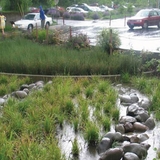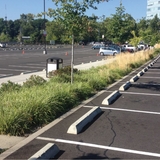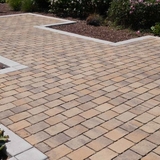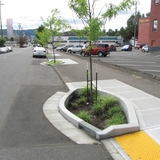O&M of Private Stormwater Measures
San Mateo County is situated between two major bodies of water, the San Francisco Bay and the Pacific Ocean. This unique location, nestled between two rich ecosystems, presents a challenge in balancing urban development and the health of the environment. Our Mediterranean climate, characterized by dry summers and rainy winters can contribute to severe flooding and associated problems in developed areas. In the past, we have been able to prevent property damage and increase reliability of our roadways through managing stormwater runoff to quickly flow away from properties and into the storm drain system which conveys water to the ocean or bay. This approach, however, has contributed to increased levels of pollution disrupting these ecosystems in the form of vehicle pollution, trash, sediment, industrial chemicals and other pollutants.
In recent years, stormwater management techniques have shifted from gray, or traditional storm drain infrastructure where runoff flows directly into the storm drain and then the receiving water, to green—that is, to a more-resilient, sustainable system that slows runoff by dispersing it to vegetated areas, harvests and uses runoff, promotes infiltration and evapotranspiration, and uses bioretention and other green infrastructure practices to clean stormwater runoff.
Stormwater Treatment Measure is a broad term that refers to a built structure or landscape feature that is designed to slow and disperse runoff from storm events by promoting onsite retention, infiltration or evapotranspiration while cleaning the runoff of pollutants including trash and harmful chemicals.
Common examples of stormwater treatment measures can be found below:

Bioretention Basin
A Bioretention Basin is designed to treat stormwater runoff by detaining water in a landscaped depression or basin and allowing the water to be cleaned of pollutants by infiltrating through soil. These basins are generally vegetated to improve water uptake and treatment.

Flow-Through Planter
A flow-through planter is an alternative to a bioretention basin that can be used when there is no available space for infiltration. Water is treated by allowing runoff to enter a hard-edged retention structure with an impermeable base. The runoff is able to soak through a soil matrix and filter into an underdrain that is connected to a stormwater pipe. Vegetation increases water removal though root uptake and evapotranspiration.

Pervious Pavement
Where landscape-based strategies are not possible or undesirable, pervious pavement can be installed to allow for treatment, detainment and infiltration of stormwater runoff without restricting use of the space for roadways, parking, sidewalks or street furniture. Permeable pavers are interlocking bricks that allow stormwater runoff to drain though aggregate between bricks. Porous concrete is specially formulated to create small pockets of space that allows runoff to drain directly through the concrete.

Tree-Box Filtration
Another solution for stormwater treatment areas that are constrained by space and lack of infiltration are Tree-Box Filters. These are self-contained systems that are relatively simple and cost-effective to install. Stormwater treatment is provided through physical, chemical and biological processes. These systems are typically connected to an underdrain which allows treated water to flow into the stormwater system.
Other Designs
There are many other designs and combinations of designs that can be used to manage and treat stormwater runoff. Each stormwater treatment measure must be individually designed and sized to meet constraints related to parcel size, underground utilities, water table depth, rainfall conditions, access requirements and a variety of other variables. Details of your system design can be found in your Property Operations and Maintenance Agreement.
One or more of these measures may be located on your property. For a description of the type and design of the stormwater treatment systems on your property, please reference the Operations and Maintenance Agreement for your property.